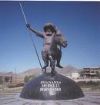|
ESL Forum:
Techniques and methods
in Language Teaching
Games, activities
and teaching ideas
Grammar and
Linguistics
Teaching material
Concerning
worksheets
Concerning
powerpoints
Concerning online
exercises
Make suggestions,
report errors
Ask for help
Message board
|
ESL forum >
Techniques and methods in Language Teaching > Fire Drill
Fire Drill
|

americorps

|
Fire Drill
|
|
Hi everyone,
I am a new ESL Instructor, currently teaching Beginner Levels students in America. I am required to explain to my beginner students the procedures for a fire drill, if one should happen.
I tried drawing simple pictures (fire - fire alarm - walk down the stairs, follow teacher - meet in parking lot) but it seemed to confuse them. I think the problem is they may not have "fire alarms" in their countries.
Any suggestions, tips, or explaination sheets on "fire drills" for BEGINNER level students would be greatly appreciated! Thank you!
Laura |
12 Oct 2009
|
|
|
|

libertybelle

|
Sometimes a picture is worth a 1000 words.
Isn �t there an official film for schools to use to show the procedure in a fire drill?
If not try finding something on YouTube.
I found this, but it isn �t that good.
http://www.youtube.com/watch?v=155DW5RDbNg
good luck
L
ps - otherwise find some pictures of a fire, then of kids leaving the classroom and going outside.
|
12 Oct 2009
|
|
|

toandfro_

|
Hi Laura, I think you �ve chosen the best way - I mean drawing the picture. You can also print a simple pic like that:
http://www.dotolearn.com/picturecards/images/imageschedule/firedrill_l.gif
and let them try to describe what they see in the picutre in their own words.
Don �t give up ;)
domi
|
12 Oct 2009
|
|
|

aftab57

|
|
These lessons are for British context but you should be able to adapt them.
|
12 Oct 2009
|
|
|
|
|

zoemorosini

|
|
HI there!
I teach beginners in Chelsea, MA (outside Boston). We have three kinds of drills: Emergency evacuation (fire drill), Shelter In Place and Lockdown.
First, I explain the most essential vocabulary and expressions: emergency, alarm, exit, come, stay together, safe/protection, with me, quiet, relax, this way, no talking, etc. I often draw things on the board, use illustrations from the internet and act or sound things out. This often includes my making a sound --like the actual alarm-- so they �re familiar with it! Trust me, it �s worth making a bit of a fool of yourself to save yourself trouble later, or (God forbid) an injury.
I practice "Shelter in Place" with them in the classroom. In essence, I lock the door, turn out the lights and we all crowd into a corner away from the door completely silently until the all-clear is given. This is often hard, as the students aren �t used to being so close to one another for so long. Nerves and boredom make giggling hard to stop. It has precipitated the need for a full unit lesson on the Columbine massacre to get the point across.
When convenient, I physically take the students out of the building with me to the safe area designated by the principal. It eliminates a lot of confusion when the time comes.
Good luck!
Zoe Morosini |
13 Oct 2009
|
|
|

Jayho

|
|
We have an emergency evacuation chart in each room. If you have one of these you can go through it and have a practice drill so that they know what to do and where to go.
|
13 Oct 2009
|
|
|

jnkar

|
|
I �m sorry, I �m a little confused... So, there �s a fire in the building, it �s a life-threatening situation and I �m supposed to explain this and lead people out to safety in English and NOT their mother tongue? Or is this the case with drills only, as a means for extra practice? Because frankly, I would want to imagine a group of terrified beginners struggling under blaring alarms to separate right from left because we �re not allowed to give them instructions in their own language. Is that school policy? |
15 Oct 2009
|
|
|